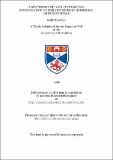Files in this item
A spectroscopic and photometric investigation of some extremely hydrogen-deficient stars
Item metadata
| dc.contributor.advisor | Hill, Philip W. | |
| dc.contributor.author | Morrison, Keith | |
| dc.coverage.spatial | 200 p. | en_US |
| dc.date.accessioned | 2018-06-20T13:11:48Z | |
| dc.date.available | 2018-06-20T13:11:48Z | |
| dc.date.issued | 1988 | |
| dc.identifier.uri | https://hdl.handle.net/10023/14343 | |
| dc.description.abstract | A photometric study of the extreme helium stars has detected three new variables (BD+1°4381, BD-1°3438, LSIV-1°2) and confirmed the suspected variability of two others (LSII+33°5, BD-9°4395). The timescale of the variations in BD+1°4381 (~"21 days), BD-1°3438 (5-8 days), LSIV-1°2 (~11 days) and LSII+33°5 (3-4 days), and the presence of colour changes concomitant with the luminosity variations, indicates that they are radial pulsators. In contrast, BD-9°4395 is believed to be pulsating non-radially. Photometric investigations of the extremely hydrogen-deficient binaries Upsilon Sagittarii, CPD-58°2721 and KS Persei are presented. KS Persei is suspected of having a ~5-day periodicity in addition to the ~30 day previously reported. A frequency analysis of the complex light curve of CPD-58°2721 shows it may be reconstructed from two sine-waves with periods of 9.3 and 14.1 days. For Upsilon Sagittarii, the results indicate that the variability previously ascribed to eclipses can instead be understood in terms of radial pulsation of the visible component, with a period of ~20 days. Additional rapid, ~0.02 mag luminosity variations with a period of 239 seconds are reported. Their origin is uncertain, and they are the shortest form of variability reported for this type of object. Theoretical modelling of the light curve indicates an early B-type main-sequence secondary with a mass of ~11M[sub] ⊙ , much higher than previously thought. A possible future merging of the binary components would result in a Type I supernova. There is no evidence of eclipses in any of the stars. A fine abundance analysis of CPD-58°2721 yielded T[sub]eff=14,000K, log g=1.25, n[sub]H:n[sub]He=0.005, n[sub]N:n[sub]c=40 and suggests an overabundance of heavy metals when compared to related objects. Its spectrum shows marked changes in the strengths of low excitation metallic lines which are evidence of temperature changes during pulsation. Spectroscopy of the surrounding nebulosity shows it to have an emission spectrum typical of an HII region. Radial-velocity measurements indicate it is probably part of the surrounding Eta Carina nebula, whilst the star is more distant. | en_US |
| dc.language.iso | en | en_US |
| dc.publisher | University of St Andrews | |
| dc.subject.lcc | QB807.M7 | |
| dc.subject.lcsh | Astrometry | en |
| dc.title | A spectroscopic and photometric investigation of some extremely hydrogen-deficient stars | en_US |
| dc.type | Thesis | en_US |
| dc.contributor.sponsor | Science and Engineering Research Council (SERC) | en_US |
| dc.type.qualificationlevel | Doctoral | en_US |
| dc.type.qualificationname | PhD Doctor of Philosophy | en_US |
| dc.publisher.institution | The University of St Andrews | en_US |
This item appears in the following Collection(s)
Items in the St Andrews Research Repository are protected by copyright, with all rights reserved, unless otherwise indicated.

